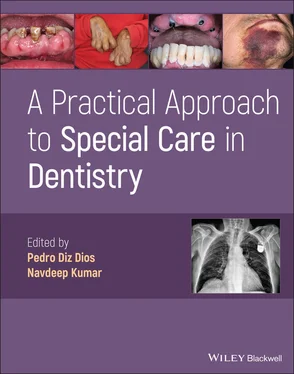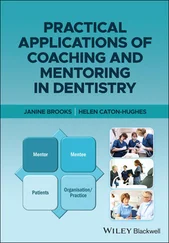A Practical Approach to Special Care in Dentistry
Здесь есть возможность читать онлайн «A Practical Approach to Special Care in Dentistry» — ознакомительный отрывок электронной книги совершенно бесплатно, а после прочтения отрывка купить полную версию. В некоторых случаях можно слушать аудио, скачать через торрент в формате fb2 и присутствует краткое содержание. Жанр: unrecognised, на английском языке. Описание произведения, (предисловие) а так же отзывы посетителей доступны на портале библиотеки ЛибКат.
- Название:A Practical Approach to Special Care in Dentistry
- Автор:
- Жанр:
- Год:неизвестен
- ISBN:нет данных
- Рейтинг книги:3 / 5. Голосов: 1
-
Избранное:Добавить в избранное
- Отзывы:
-
Ваша оценка:
- 60
- 1
- 2
- 3
- 4
- 5
A Practical Approach to Special Care in Dentistry: краткое содержание, описание и аннотация
Предлагаем к чтению аннотацию, описание, краткое содержание или предисловие (зависит от того, что написал сам автор книги «A Practical Approach to Special Care in Dentistry»). Если вы не нашли необходимую информацию о книге — напишите в комментариях, мы постараемся отыскать её.
Learn to treat dental patients with disabilities or who are medically compromised A Practical Approach to Special Care in Dentistry
A Practical Approach to Special Care in Dentistry
A Practical Approach to Special Care in Dentistry — читать онлайн ознакомительный отрывок
Ниже представлен текст книги, разбитый по страницам. Система сохранения места последней прочитанной страницы, позволяет с удобством читать онлайн бесплатно книгу «A Practical Approach to Special Care in Dentistry», без необходимости каждый раз заново искать на чём Вы остановились. Поставьте закладку, и сможете в любой момент перейти на страницу, на которой закончили чтение.
Интервал:
Закладка:
Long‐term complications cause significant morbidity and mortalityOverproduction of reactive oxygen species as a result of metabolic disturbance results in endothelial dysfunction and inflammation; this provokes diabetic vascular changesMacrovascular changes include: Table 5.1.3 Criteria for the diagnosis of diabetes (WHO).NormalPrediabetesDiabetesFasting plasma glucose (FPG)≤5.5 mmol/L (<100 mg/dL)5.6–6.9 mmol/L (100–125 mg/dL)≥7.0 mmol/L (126 mg/dL)Oral glucose tolerance test (OGTT) – 2 hours after 75 g anhydrous glucose dose dissolved in water≤7.7 mmol/L (<140 mg/dL)7.8–11.0 mmol/L (140–199 mg/dL)≥11.1 mmol/L (200 mg/dL)Glycated haemoglobin in plasma (HbA1c) – glycaemic history for lifespan of an erythrocyte (2–3 months)≤39 mmol/mol (<5.7%)(39–47 mmol/mol) (5.7–6.4%)≥48 mmol/mol (≥6.5%)Symptoms of high blood sugar and random plasma glucose test––≥11.1 mmol/L (200 mg/dL)Angina pectoris, myocardial infarction, cerebral infarction and claudicationMicrovascular changes include:Diabetic retinopathy (neovascularisation, vitreous haemorrhaging, retinal detachment and blindness)Diabetic nephropathy, which is the main cause of dialysis and kidney transplantation in high‐income countriesPeripheral sensory polyneuropathy and autonomic neuropathyRecurrent infectionsDelayed healingIncreased risk of developing dementia
Diagnosis
When symptoms of diabetes are present, 2 or more repeat tests are undertaken to confirm the diagnosis, as summarised in Table 5.1.3
Elevated HbA1c is a risk factor for the development of coronary heart disease and stroke
In conditions associated with increased red blood cell turnover, such as sickle cell disease, pregnancy (second and third trimesters), haemodialysis, recent blood loss or transfusion, or erythropoietin therapy, only plasma blood glucose criteria should be used to diagnose diabetes
Haemoglobin variants can also interfere with the measurement of HbA1c (e.g. sickle cell trait).
Serum fructosamine levels may be considered as an appropriate laboratory measurement when monitoring long‐term glycaemic control in patients with underlying haemoglobinopathies
Management
Diet and regular physical exercise
Oral hypoglycaemic agentsSulfonylureas (e.g. glipizide, glyburide, glimepiride and tolazamide)Meglitinides (e.g. repaglinide and nateglinide)DDP‐4 inhibitors (e.g. sitagliptin)Biguanides (e.g. metformin)Alpha‐glucosidase inhibitors (e.g. acarbose and miglitol)Thiazolidinediones (e.g. pioglitazone and rosiglitazone)
InsulinSeveral types of human insulin according to the speed and duration of their effects ( Table 5.1.4)Generally, individuals with diabetes are controlled with 2 administrations of subcutaneous fast‐acting or intermediate insulin (first hour of the morning and middle of the afternoon)Insulin can also be administered with a continuous release pump (especially indicated for patients with considerable blood glucose variability)
Classically, glycaemic control has been performed with home (electronic glucometers) and professional monitoring (blood glucose and HbA1c levels)
Continuous glucose monitoring systems consist of a subcutaneous sensor and a transmitter that sends the signal to a receiver by which the reading can be taken ( Figure 5.1.4); this process can even be controlled with a smart phone; these devices are also the basis of the so‐called ‘artificial pancreas’, which injects the required insulin doses in real time
Other treatments under development include the transplantation of pancreatic islets and pluripotent stem cell‐derived insulin‐producing cells Table 5.1.4 Types of insulin and their action profiles.Main types of insulinInjection timingStart of actionMaximum effectDuration of effectFast‐acting insulin30 minutes before meals30 minutes1–3 hours6–8 hoursUltrafast‐acting insulin analogues10 minutes before meals10–20 minutes1–2 hours3–5 hoursIntermediate‐acting insulin30 minutes before meals60–120 minutes4–6 hours10–12 hoursLong‐acting insulin analoguesAt the same time every day60–90 minutes12 hours17–24 hours
Prognosis
Life expectancy of a person with type 2 diabetes mellitus is likely to be reduced, by up to 10 years
People with type 1 diabetes mellitus traditionally have a life expectancy reduced by over 20 years, although improvements in diabetes care in recent decades have meant that people are now living significantly longer
The prognosis is better for patients who respond adequately to drug treatment and appropriate dietary and general health measures
Multiorgan complications (renal failure, heart disease, stroke, blindness, limb amputation and peripheral neuropathy) can affect life expectancy and quality
Approximately 3% of all deaths worldwide are attributable to diabetes. This percentage increases to 8.5% if we include deaths caused by the cardiovascular disease and renal failure directly related to diabetes, which represent 5 million adult deaths annually
A World/Transcultural View
The prevalence of diabetes is related to the community's socio‐economic conditions, given that 75% of individuals with diabetes live in low‐ or middle‐income countries
The adoption by some indigenous communities (e.g. in South Africa and Australia) of a Western diet has resulted in a considerable increase in cases of non‐insulin‐dependent diabetes mellitus
Countries as heterogeneous as India, the US and Saudi Arabia have shown that dental clinics can be important centres for detecting previously undiagnosed diabetes and prediabetes Figure 5.1.4 Continuous glucose monitoring system.
Recommended Reading
1 Borgnakke, W.S. (2019). IDF diabetes atlas: diabetes and oral health – a two‐way relationship of clinical importance. Diabetes Res. Clin. Pract. 157: 107839.
2 Diabetes Canada Clinical Practice Guidelines Expert Committee, Lipscombe, L., Butalia, S. et al. (2020). Pharmacologic glycemic management of type 2 diabetes in adults: 2020 update. Can. J. Diabetes 44: 575–591.
3 Johnson, E., Warren, F., Skolnik, N., and Shubrook, J.H. (2016). Diabetes update: your guide to the latest ADA standards. J. Fam. Pract. 65: 310–318.
4 Lalla, E. and Papapanou, P.N. (2011). Diabetes mellitus and periodontitis: a tale of two common interrelated diseases. Nat. Rev. Endocrinol. 7: 738–748.
5 McKenna, S.J. (2006). Dental management of patients with diabetes. Dent. Clin. North Am. 50: 591–606.
6 Miller, A. and Ouanounou, A. (2020). Diagnosis, management, and dental considerations for the diabetic patient. J. Can. Dent. Assoc. 86: k8.
7 Wilson, M.H., Fitzpatrick, J.J., McArdle, N.S., and Stassen, L.F. (2010). Diabetes mellitus and its relevance to the practice of dentistry. J. Ir. Dent. Assoc. 56: 128–133.
8 Wray, L. (2011). The diabetic patient and dental treatment: an update. Br. Dent. J. 211: 209–215.
5.2 Hypothyroidism
Section I: Clinical Scenario and Dental Considerations
Clinical Scenario
A 22‐year‐old female presents for an emergency dental appointment complaining of unbearable pain in the region of the left angle of the mandible. The patient initially experienced discomfort 3 days ago, but this intensified overnight leading to disturbed sleep and a persistent throbbing ache.
Medical History
Autoimmune hypothyroidism (Hashimoto' disease) diagnosed 2 years ago
Autoimmune hepatitis diagnosed 4 years ago
Poor compliance with the treatment of her autoimmune disease; fails to attend review appointments with her physician, takes medication irregularly
Obstructive sleep apnoea‐hypopnoea syndrome
Читать дальшеИнтервал:
Закладка:
Похожие книги на «A Practical Approach to Special Care in Dentistry»
Представляем Вашему вниманию похожие книги на «A Practical Approach to Special Care in Dentistry» списком для выбора. Мы отобрали схожую по названию и смыслу литературу в надежде предоставить читателям больше вариантов отыскать новые, интересные, ещё непрочитанные произведения.
Обсуждение, отзывы о книге «A Practical Approach to Special Care in Dentistry» и просто собственные мнения читателей. Оставьте ваши комментарии, напишите, что Вы думаете о произведении, его смысле или главных героях. Укажите что конкретно понравилось, а что нет, и почему Вы так считаете.












